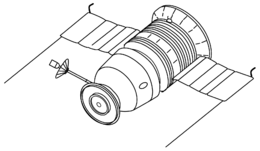Zond 4
Zond 4, part of the Soviet Zond program and an uncrewed version of Soyuz 7K-L1 crewed Moon-flyby spacecraft, was one of the first Soviet experiments towards crewed circumlunar spaceflight. It was launched to test the spaceworthiness of the new capsule and to gather data about flights in circumterrestrial space. It was the first Soviet spacecraft to possess a computer, the 34 kg Argon 11.[1]
 | |
| Names | Soyuz 7K-L1 s/n 6 |
|---|---|
| Mission type | Lunar flyby Spacecraft test |
| Operator | OKB-1 |
| COSPAR ID | 1968-013A |
| SATCAT no. | 03134 |
| Spacecraft properties | |
| Bus | Soyuz 7K-L1 |
| Manufacturer | OKB-1 |
| Launch mass | 5,140 kilograms (11,330 lb) |
| Dimensions | 4.5 m x 2.2 m x 2.72 m |
| Start of mission | |
| Launch date | 2 March 1968, 18:29:23 UTC |
| Rocket | Proton-K/D |
| Launch site | Baikonur 81/6 |
| End of mission | |
| Disposal | deorbited/destroyed |
| Decay date | 7 March 1968 |
| Landing site | Gulf of Guinea |
| Orbital parameters | |
| Reference system | Geocentric |
| Regime | Low Earth |
| Perigee altitude | 192 kilometres (119 mi) |
| Apogee altitude | 205 kilometres (127 mi) |
| Inclination | 51.53° |
| Period | 88.41 minutes |
The spacecraft was successfully launched into a 354,000 km apogee orbit 180 degrees away from the Moon, It was launched away from the Moon probably to avoid trajectory complications with lunar gravity. However, on re-entry the L1's guidance system failed. It hit the atmosphere precisely at the calculated time, but was not guided to generate lift and fly out of the atmosphere again. A ballistic re-entry would mean no recovery on Soviet soil, so the APO destruct system automatically blew up the capsule at 10 to 15 km altitude, 180–200 km off the African coast at Guinea.
References
- Huntress; Marov (2011). Soviet Robots in the Solar System: Mission Technologies and Discoveries. p. 172.
